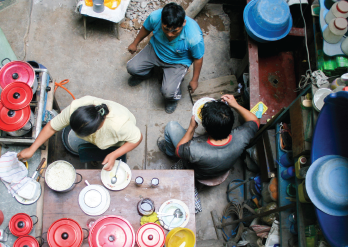
Ruslana Iurchenko / shutterstock.com
Indigenous communities in Latin America lack good healthcare—and often lack any healthcare—for musculoskeletal and rheumatic diseases.1 Global health initiatives tend to focus on infectious disease, despite the increasing rate of chronic diseases.
In a survey of 6,155 individuals from eight indigenous communities, conducted by a team of Latin American investigators, the prevalence of these conditions was 34.5%. The research was published July 14, 2018, in Annals of the Rheumatic Diseases.1
“That’s a higher prevalence than anywhere in the world, and it’s higher in a younger population,” says Leigh F. Callahan, PhD, noting the mean age of study subjects was 41.2 years. “I think the reason for this high rate is that these indigenous individuals have very low levels of socioeconomic status, which is well known to correlate with disease prevalence, morbidity and mortality.” Dr. Callahan, who was not involved in the study, is the Mary Link Briggs distinguished professor of medicine, and associate director, Thurston Arthritis Research Center, the University of North Carolina, Chapel Hill.
The study authors (Peláez-Ballestas et al.) note that indigenous communities seeking healthcare face “geographical and linguistic barriers, low social support and a paucity of healthcare policies for providing culturally sensitive care.”
In a quest to better understanding the toll taken by musculoskeletal diseases, and the causes of those diseases, Peláez-Ballestas et al. took a syndemic approach—first proposed March 2017 in a dedicated issue of Lancet.2
The syndemic approach posits “the interaction of two or more biological diseases, in different sociocultural situations and in the context of varying healthcare standards, exacerbates their deleterious effects on the health of individuals, communities, and societies,” the authors write.
The challenge was to find a way to measure the combined impact of multiple comorbidities, such factors as drinking, smoking, socioeconomic status and education level, and other influences on the severity of rheumatic diseases. To that end, the team enlisted a computational sciences expert, Alfonso Gastelum-Strozzi, PhD, research associate, Department of Instrumentation and Measurement Universidad Nacional Autónoma de México, Mexico City. He proposed doing a “network analysis”—a new technique—as a way to study the relationships among the influencing factors, and to visually represent those relationships.
The investigators used the cross-culturally validated Community Oriented Program for Control of Rheumatic Diseases (COPCORD) questionnaire to identify probable cases of rheumatic disease. These cases were then diagnosed by general practitioners and rheumatologists. “The questionnaire explored [musculoskeletal] symptoms (e.g., pain, stiffness, disability), treatments, coping mechanisms and the process of seeking [treatment with] biomedical and/or traditional medicine,” according to the report. The investigators defined positive cases as musculoskeletal pain in any region during the past seven days, or at least once during a lifetime.
Results
Among all eight indigenous communities, 35% of the total population surveyed had experienced musculoskeletal pain during the previous seven days, and 45% had experienced such pain at some point during their lifetimes.
The most prevalent rheumatic diseases among this population—61% female—were low back pain and osteoarthritis, 13.3% and 9.7%, respectively. These were followed by rheumatic regional pain syndromes (5.9%), rheumatoid arthritis (1.3%), undifferentiated arthritis (0.2%) and spondyloarthritis (0.1%). Overall prevalence and prevalence for individual conditions varied widely by community.
Prevalence of comorbidities included 17.5% with obesity, 16% with depression, 13.7% with high blood pressure, 13.3% with gastritis, 6.8% with type 2 diabetes mellitus and 4.9% with peripheral vascular disease.
Prevalence of behavioral health issues included 22.5% reporting drinking alcohol and 13.3% reporting smoking.
Current physical limitations due to rheumatic diseases impaired 15.5% of respondents, and 9.7 “were not coping with discomfort,” according to the report.
But there were large differences in these findings among the eight communities. For example, 65.3% of both the Mixteco and Chontal communities reported historical pain, compared with 14.7% of the Raramuri.
“This is a population that really needs to be targeted with interventions on the prevention level, as well as treatment,” says Dr. Callahan. “Thirty-three percent have no healthcare at all. And some [entire communities] had no healthcare.”
“Only 3% reported having complete social insurance [i.e., insurance that covers all necessary health-related expenses],” according to the report. Despite the fact that 59.8% were covered by some form of national health insurance, “… only half of participants reported seeking medical care to manage their [rheumatic disease], and 40.6% have never sought medical or traditional treatment despite the high prevalence of severe [musculoskeletal] pain, disability and poor coping.”
Network Analysis
The investigators used network analysis to examine the relationship between socioeconomic and clinical variables. (See https://ard.bmj.com/content/77/10/1397.full.) The network analysis confirmed that rheumatic diseases are complex, chronic and often associated with other disease, says principal investigator Ingris Peláez-Ballestas, MD, PhD, researcher in medical sciences, General Hospital of Mexico, Mexico City. She adds that these conditions harm people—especially indigenous people—socioeconomically, in part because geographical and linguistic challenges, as well as economic limitations often put medical care out of their reach.
“Non-inflammatory [musculoskeletal] disorders … are associated with high physical demand, overweight and obesity, and pose a risk of accelerating degenerative process of the joints,” according to the report. “This is further exacerbated by healthcare inequity, fragmented healthcare systems and high vulnerability of the population, which is true for many indigenous communities in countries lacking public health strategies to prevent or reduce disability.”
Thus, these conditions—both physical and socioeconomic—undermine ability to work. That’s doubly harmful because work is fundamental to sense of self within these indigenous communities, says Dr. Peláez-Ballestas.
Not surprisingly, Dr. Callahan notes that of the myriad variables in this analysis, working had the greatest “authority.” Authority is a function of the number of people to whom a variable applies—who work, for example—and the number of connections that variable has to other variables. For example, rheumatic diseases result in varying degrees of disability—a variable to which work is strongly connected in the network analysis—as it is to smoking, to alcoholism, to “other comorbidities,” and to other rheumatic and medical conditions.
One of the beauties of the network analysis is that it raises new questions. “Do people with back pain drink more?” says Dr. Gastelum-Strozzi. The network analysis shows a strong connection between the two variables. But, he adds, to confirm a hypothesis, one must do a study.
Another advantage of the network analysis is that it can identify oft-differing challenges faced by different communities of indigenous people. “That allows us to design tailored community-based interventions,” says Dr. Peláez-Ballestas.
Lessons for Rheumatologists
“We have seen consistently across the United States that individuals with fewer years of formal education and lower markers of socioeconomic status have increased prevalence of disease, poorer outcomes and increased mortality,” says Dr. Callahan.
Rheumatologists need to bear in mind the social aspects of the lives of their patients when such a patient is in their office, says Dr. Callahan. Given rheumatologists’ frequent shortage of time, referrals for more extended patient education might be indicated.
Dr. Callahan advises use of the teach-back method to ensure patients understand how to treat themselves at home—“for instance, telling the patient, ‘We’ve covered a lot of information today; I want to make sure I’ve made myself clear. Can you tell me how you are going to manage your disease when you get home?’”
Dr. Callahan suggests rheumatologists need to make sure that at the end of the visit they encourage the patient to ask questions, by asking, “What questions do you have?” rather than, “Do you have any questions?” which she says can make a patient feel cut off.
Additionally, Dr. Callahan urges considering low socioeconomic status above race as an indicator a patient may need extra attention, “since low socioeconomic status is a marker for a whole constellation of deprivations that cut across all races.”
“This paper reminds us that [Native Americans] are also heavily affected by rheumatic disease,” says Donald R. Miller, PharmD, professor, pharmacy practice, School of Pharmacy, College of Health Professions, North Dakota State University, Fargo, who was not involved in the research. “Rheumatologists may need to be more vigilant for diagnoses in [Native Americans], and may need to take a more holistic approach to treatment in special populations.”
Jim Jarvis, MD, professor of pediatrics at the University at Buffalo, Jacobs School of Medicine, and a member of the Mohawk Nation, referring to the ongoing Adverse Childhood Experiences Study, suggests that early childhood trauma—physical or emotional—may play an important role in these diseases.3 Dr. Jarvis says that early in his examination of high rates of rheumatic diseases among Indians, a Cheyenne elder told him that to understand the high rates of lupus and rheumatoid arthritis in Indians, “look at our people and what’s happened to us.” Thus, some emphasis on early history taking may be indicated.
David C. Holzman writes on medicine, science, environment and energy from Lexington, Mass.
References
- Peláez-Ballestas I, Granados Y, Quintana R, et al. Epidemiology and socioeconomic impact of the rheumatic diseases on indigenous people: An invisible syndemic public health problem. Ann Rheum Dis. 2018 Oct;77(10):1397–1404.
- Syndemics. Lancet. 2017 Mar 2;389(10072).
- Felitti VJ, Anda RF, Norenberg D, et al. Relationship of childhood abuse and household dysfunction to many of the leading causes of death in adults. The Adverse Childhood Experiences (ACE) Study. Am J Prev Med. 1998 May;14(4):245–258.

